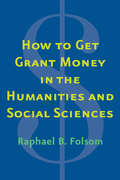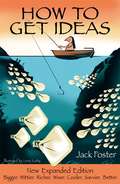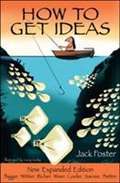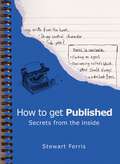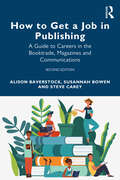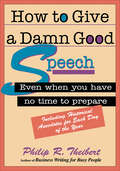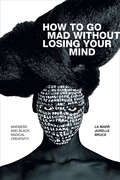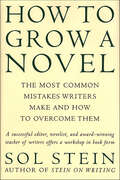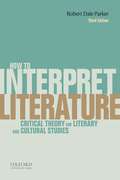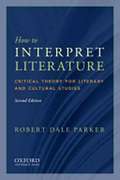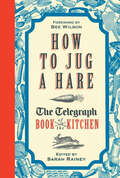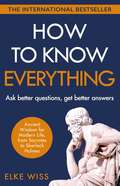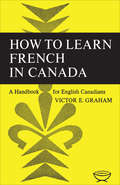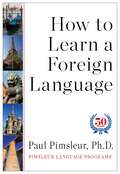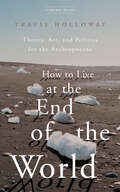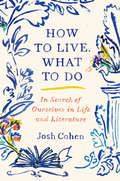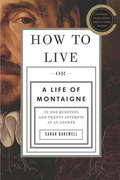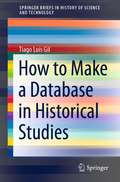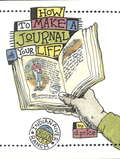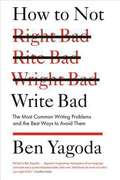- Table View
- List View
How to Get Grant Money in the Humanities and Social Sciences
by Raphael Brewster FolsomA valuable and engaging guide to applying for—and getting—grants in the humanities and social sciences Scholars in the humanities and social sciences need money to do research. This book shows them how to get it. In this accessible volume, Raphael Folsom shares proven strategies in a series of short, witty chapters. It features tips on how graduate students, postdocs, and young faculty members can present themselves and their work in the best possible light. The book covers the basics of the grant-writing process, including finding a mentor, organizing a writing workshop, conceptualizing the project on a larger scale, and tailoring an application for specific submissions. The book includes interviews with nine of the most respected scholars in the country, each of whom has evaluated thousands of grant applications. The first authoritative book on the subject, Folsom's indispensable work will become a must-have resource for years to come.
How to Get Ideas
by Jack Foster Larry CorbyThis new expanded second edition is an international bestseller with over 200,000 copies sold and translated into 15 languages that shows you—no matter your age or skill, your job or training—how to come up with more ideas, faster and easier. Jack Foster's simple five-step technique for solving problems and getting ideas takes the mystery and anxiety out of the idea-generating process. It's a proven process that works. You'll learn to condition your mind to become "idea-prone," utilize your sense of humor, develop your curiosity, visualize your goals, rethink your thinking, and overcome your fear of rejection. This expanded edition of the inspiring and enlightening classic features new information on how to turn failures to your advantage and how to create a rich, idea-inducing environment. Dozens of new examples and real life stories show that anyone can learn to get more and better ideas.
How to Get Ideas: Nothing Is More Difficult Than Coming Up with That Original Idea
by Jack FosterWritten by Jack Foster, a creative director for various advertising agencies with more than 40 years experience, How to Get Ideas is a fun, accessible, and practical guide that takes the mystery and confusion out of developing new ideas.
How to Get Published: Secrets from the Inside
by Stewart FerrisEveryone has a book in them, they say. Having gone through the process of extracting a masterpiece from your head what happens next? In most cases the book will end up in a desk drawer as a pile of papers or inside a computer. But that's not what you want, is it? You wrote it to get published. You want to see your name in print, to go into bookshops and see your book on the shelves. You want to feel that moment of pride when you see someone on the bus reading your book. The concept that a good book will always find a publisher is outdated and over-simplistic. The truth is that most writers remain unpublished because they pay attention only to the quality of their writing. Publishers are business people. Their job is to make money from selling books. They know that high quality writing alone isn't always enough to make a profitable book, so when choosing which manuscripts to sign up for publication they think about many more elements than just the words on the page. After 15 years in the book industry, Stewart Ferris has identified all of the crucial factors that publishers consider besides good writing. How to Get Published reveals for the first time these inside secrets and provides tactics that any writer can use to create the perfect conditions for their own 'lucky break' to happen. *Why books get accepted *How publishing works *How to find a publisher *What to put in a submission *How to write a sizzling synopsis *10 ways to leapfrog other submissions *Sending multiple submissions *Easily avoidable reasons why books get rejected *16 crucial factors that publishers consider when deciding what to publish *And much more! Stewart Ferris has published 500 books, rejected 10,000 submissions, and is the author of more than 20 books.
How to Get Published: Secrets from the Inside
by Stewart FerrisEveryone has a book in them, they say. Having gone through the process of extracting a masterpiece from your head what happens next? In most cases the book will end up in a desk drawer as a pile of papers or inside a computer. But that's not what you want, is it? You wrote it to get published. You want to see your name in print, to go into bookshops and see your book on the shelves. You want to feel that moment of pride when you see someone on the bus reading your book. The concept that a good book will always find a publisher is outdated and over-simplistic. The truth is that most writers remain unpublished because they pay attention only to the quality of their writing. Publishers are business people. Their job is to make money from selling books. They know that high quality writing alone isn't always enough to make a profitable book, so when choosing which manuscripts to sign up for publication they think about many more elements than just the words on the page. After 15 years in the book industry, Stewart Ferris has identified all of the crucial factors that publishers consider besides good writing. How to Get Published reveals for the first time these inside secrets and provides tactics that any writer can use to create the perfect conditions for their own 'lucky break' to happen. *Why books get accepted *How publishing works *How to find a publisher *What to put in a submission *How to write a sizzling synopsis *10 ways to leapfrog other submissions *Sending multiple submissions *Easily avoidable reasons why books get rejected *16 crucial factors that publishers consider when deciding what to publish *And much more! Stewart Ferris has published 500 books, rejected 10,000 submissions, and is the author of more than 20 books.
How to Get a Job in Publishing: A Guide to Careers in the Booktrade, Magazines and Communications
by Alison Baverstock Susannah Bowen Steve CareySo you’ve always dreamed of a career in publishing… but you don’t know where to start or how? You’re holding the key in your hands! Using insider information, How to Get A Job in Publishing is the newly revised edition of the classic text for you if you are keen to work in publishing or associated industries – or if you are already in publishing and want to go further. Packed with real-life quotes, case studies and practical advice from publishing veterans, and more recent arrivals, the authors differentiate types of publishing and explain how roles and departments work together. They discuss the pros and cons of internships and further study as well as training and lifelong learning, working internationally, networking and building your personal brand. The book includes vital guidelines for applying for publishing roles, including sample CVs and cover letters and a glossary of industry terms, to make sure you stand out from the crowd when you apply for jobs. This thoroughly updated edition covers: • The post-pandemic publishing world, changes and current controversies, the rise of e-books, Amazon, self-publishing and indie publishing. • The growth in tertiary courses in Publishing Studies and internships – are they really the best way in? • How to create your CV and a compelling cover letter that gets you noticed. A new chapter addresses equity, diversity, inclusion and belonging, reflecting on the current state of the publishing industry, how to evaluate potential employers and how to look after yourself and others at work. Whether you are a new or soon-to-be graduate of Media and Publishing, or are just interested in a career in publishing or the creative industries, How to Get A Job in Publishing is an essential resource.
How to Give a Damn Good Speech (30-Minute Solutions)
by Philip R. TheibertThe best advice, openings, stories, and facts for a standout speech—from a professional speechwriter for CEOs, political figures, and other top officials.Don’t let the mere thought of presenting a speech tie your stomach in knots and put you in state of sheer panic. Philip Theibert, author of Business Writing for Busy People, has written How to Give a Damn Good Speech to help you give any speech, sounding like a seasoned pro. He provides a blueprint for producing a professional, thought-provoking, friendly, and authoritative speech, even when you have very little time to prepare.How to Give a Damn Good Speech provides you with professional speech writers’ techniques to make each and every speech a powerful presentation. Theibert has done years of research and has read thousands of speeches in an effort to better illustrate his points and bring you the best examples possible. You can read the book in its entirety or, if you simply need a refresher, you can read the section that best suits your needs. This format allows you to focus on areas of your speech that most need help. Topics covered include:How to organize and write a speech100 important things you need to know about giving an effective speechInteresting and entertaining stories to use in any speechBest quotations ever heardHistorical anecdotes for each day of the yearHow to Give a Damn Good Speech, with its easy-to-read, accessible style, makes writing and giving speeches a breeze, and will prevent you from turning green the next time you’re asked to give a speech.
How to Go Mad without Losing Your Mind: Madness and Black Radical Creativity (Black Outdoors: Innovations in the Poetics of Study)
by La Marr Bruce“Hold tight. The way to go mad without losing your mind is sometimes unruly.” So begins La Marr Jurelle Bruce's urgent provocation and poignant meditation on madness in black radical art. Bruce theorizes four overlapping meanings of madness: the lived experience of an unruly mind, the psychiatric category of serious mental illness, the emotional state also known as “rage,” and any drastic deviation from psychosocial norms. With care and verve, he explores the mad in the literature of Amiri Baraka, Gayl Jones, and Ntozake Shange; in the jazz repertoires of Buddy Bolden, Sun Ra, and Charles Mingus; in the comedic performances of Richard Pryor and Dave Chappelle; in the protest music of Nina Simone, Lauryn Hill, and Kendrick Lamar, and beyond. These artists activate madness as content, form, aesthetic, strategy, philosophy, and energy in an enduring black radical tradition. Joining this tradition, Bruce mobilizes a set of interpretive practices, affective dispositions, political principles, and existential orientations that he calls “mad methodology.” Ultimately, How to Go Mad without Losing Your Mind is both a study and an act of critical, ethical, radical madness.
How to Grow Tomatoes
by Kristin Cashore Nicole WongThe fun and excitement of English and Language Arts learning continues in Grade 2 of Reading Street. This comprehensive and dynamic curriculum for homeschooling is geared toward young children who have some foundational English and Language Arts knowledge and are ready to strengthen their skills. Comprised of engaging activities, challenging content and weekly quizzes, Reading Street: Grade 2 is the next step in your child's path toward becoming a lifelong learner and reader. As with all Reading Street products, the Grade 2 system is formatted to help students meet certain age-appropriate goals. After completing this English and Language Arts homeschool program, your child should be able to: Read and comprehend two-syllable words. Identify common prefixes (such as pre-, un-, or re-) and suffixes (such as -able, -ad and -er). Correct mistakes made when reading out loud. Read books with two or more chapters. Understand the structure of stores (i. e. beginning, middle and end). Start selecting reading materials based on his/her own interests. Identify the "who," "what," "when," "where," "why" and "how" of the text. While the goals of second Grade English and Language Arts are numerous, Reading Street will help you craft engrossing lessons. Your child will garner important English and Language Arts skills while completing a workbook, reading stories and poems, and taking assessments. Planning these lessons will be easier than ever, as all Reading Street systems are broken down into weekly Big Ideas. All the work your child does on a given week is formulated around that single concept for an organized and challenging curriculum. With six easy-to-follow units, Reading Street: Grade 2 is the perfect tool for homeschooling parents. Your child will enjoy the reading selections and activities, and you'll love to see your student growing into a knowledgeable individual. We're confident that this product is the right one for you. For more information on the specific materials found in Grade 2 of Reading Street, check out the Features and Benefits page.
How to Grow a Novel: The Most Common Mistakes Writers Make and How to Overcome Them
by Sol SteinEach year thousands of fiction writers, from beginners to bestselling author, benefit from Sol Stein's sold-out workshops, featured appearances at writers' conferences, software for writers, on-line columns, and his popular first book for writers, Stein on Writing. Stein practices what he teaches: He is the author of nine novels, including the million-copy bestseller The Magician, as well as editor of such major writers as James Baldwin, Jack Higgins, Elia Kazan, Budd Schulberg, W. H. Auden, and Jacques Barzun, and the teacher and editor of several current bestselling authors. What sets Stein apart is his practical approach. He provides specific techniques that speed writers to successful publication.How to Grow a Novel is not just a book, but an invaluable workshop in print. It includes details and examples from Stein's editorial work with a #1 bestselling novelist as well as talented newcomers. Stein takes the reader backstage in the development of memorable characters and fascinating plots. The chapter on dialogue overflows with solutions for short-story writers, novelists, screenwriters, and playwrights. Stein shows what readers are looking for-- and what they avoid-- in the experience of reading fiction. The book offers guidelines-- and warnings-- of special value for nonfiction writers who want to move into fiction. Stein points to the little, often overlooked things that damage the writer's authority without the writer knowing it. And this book, like no other writing book, takes the reader behind the scenes of the publishing business as it affects writers of every level of experience, revealing the hard truths that are kept behind shut doors.
How to Interpret Literature: Critical Theory for Literary and Cultural Studies
by Robert Dale ParkerOffering a refreshing combination of accessibility and intellectual rigor, How to Interpret Literature presents an up-to-date, concise, and wide-ranging historicist survey of contemporary thinking in critical theory. The only book of its kind that thoroughly merges literary studies with cultural studies, this text provides a critical look at the major movements in literary studies since the 1930s, including those often omitted from other texts. It is also the only up-to-date survey of literary theory that devotes extensive treatment to Queer Theory and Postcolonial and Race Studies. How to Interpret Literature is ideal as a stand-alone text or in conjunction with an anthology of primary readings such as Robert Dale Parker's Critical Theory: A Reader for Literary and Cultural Studies.
How to Interpret Literature: Critical Theory for Literary and Cultural Studies
by Robert Dale ParkerOffering a refreshing combination of accessibility and intellectual rigor, How to Interpret Literature: Critical Theory for Literary and Cultural Studies, Second Edition, presents an up-to-date, concise, and wide-ranging historicist survey of contemporary thinking in critical theory. <p><p> The only book of its kind that thoroughly merges literary studies with cultural studies, this text provides a critical look at the major movements in literary studies since the 1930s, including those often omitted from other texts. It is also the only up-to-date survey of literary theory that devotes extensive treatment to Queer Theory and Postcolonial and Race Studies. How to Interpret Literature, Second Edition, is ideal as either a stand-alone text or in conjunction with an anthology of primary readings such as Robert Dale Parker's Critical Theory: A Reader for Literary and Cultural Studies.
How to Interpret Literature: Critical Theory for Literary and Cultural Studies
by Robert Dale ParkerOffering a refreshing combination of accessibility and intellectual rigor, How to Interpret Literature: Critical Theory for Literary and Cultural Studies, Fourth Edition, presents an up-to-date, concise, and wide-ranging historicist survey of contemporary thinking in critical theory. The only book of its kind that thoroughly merges literary studies with cultural studies, this text provides a critical look at the major movements in literary studies from the 1930s to the present. It is the only up-to-date survey of literary theory that devotes extensive treatment to queer studies, postcolonial and race studies, environmental criticism, and disability studies. How to Interpret Literature is ideal as a stand-alone text or in conjunction with an anthology of primary readings, like Robert Dale Parker's Critical Theory: A Reader for Literary and Cultural Studies.
How to Jug a Hare: The Telegraph Book of the Kitchen
by Sarah Rainey and Bee WilsonFeaturing a forward by a bestselling food writer from The Telegraph, this collection from the newspaper’s archives celebrates all things culinary.The opening of the Savoy in 1889, with Auguste Escoffier at the helm of its kitchen, rang in the new era of the celebrity chef. Though food is intrinsic to our very existence, the public’s interest was piqued and our pursuit of gastronomy has been on the rise ever since. Fortunately, The Telegraph has been there to document it.Trawling through the archives, features writer Sarah Rainey, has read through the great and the good as well as the more nostalgic recipes and culinary contemplations. Contributions from literary figures and their kitchens such as A.S. Byatt, sit beautifully alongside the slightly less erudite but equally wonderful entries that are a snapshot into the era they were written.The hidden gems of the past include interviews with “up-and-coming” chefs including Richard Stein, producing the best of New British Cooking in Padstow, not to mention the flamboyant Egon Ronay extolling the virtues of the “new” trend of coffee houses.Sometimes preventing hollandaise from splitting when you are sweating in a hot kitchen is just not worth it. So take some time out, sit down and read about what Mary Berry did before Great British Bake Off, how Heston Blumenthal wasn’t the first person to make weird flavours of ice cream and the trade tips from the perennially progressive Elizabeth David.With a foreword by food journalist and author Bee Wilson, this collection is the perfect gift for your favorite foodie or home chef.
How to Know Everything: Ask better questions, get better answers
by Elke WissThe international bestseller that will sharpen your mind, broaden your perspective and transform your relationships._____________________________________________________WHY ARE WE SO BAD AT ASKING GOOD QUESTIONS?In an increasingly polarized world, asking better questions in our daily and working lives is a radical shortcut to personal and professional success. It can create space for us to rethink our positions, find answers together, and even change our minds for the better.Drawing on the lessons of Socrates and other great thinkers, practical philosopher Elke Wiss lays out an essential toolkit to help you:· Transform debates into dialogues · Embrace your doubts like a true philosopher· Ditch your ego and become an active listener· Discover an open and curious Socratic attitude· Learn Sherlock Holmes's powers of observation · Open conversations up or dig down deeper with key question types· Explore thorny issues and avoid classic question pitfalls· Face your fear of asking and start connectingThe right questions can unlock the answers to anything - and help you know everything, without being a know-it-all. _____________________________WHAT READERS ARE SAYING:'Read this book, it will enrich your life!''A disarming and urgent book in today's world!''A great book for anyone who wants to better understand themselves and others!''Everyone should read this. What fascinating conversations we would have then!''A clear and practical book for brave thinkers who want to start having better, deeper conversations.''I found this book so valuable! A real enrichment to my daily life.' 'What a gem this book is!''Highly recommended for anyone who usually gets bogged down in discussions, quarrels, disagreements that lead to nothing.''A ray of hope in a time of dispute and polarization.' 'Elke Wiss makes practical philosophy manageable for everyone. A must read!''A cheerful, unconventional book.' 'An inspiring, easy-to-read book, full of practical exercises to get yourself started right away. For me it's a must read!''Its powerful message urges us to connect more with each other and with ourselves.''Some books can actually change your worldview or your daily actions, and as far as I'm concerned this is one of them. I recommend it to everyone.'
How to Learn French in Canada: A Handbook for English Canadians
by Victor E GrahamIt is well known that even after several years' exposure to high-school French, most English Canadians remain unable to speak the language. It is equally well known that many French Canadians are bilingual. One of the more obvious explanations for this relative deficiency on the part of the English Canadian is his lack of opportunities to use the French language in day-to-day situations, and, conversely, the French Canadian's need to know the second language, too often perhaps for economic reasons. Professor Graham's book gives useful and practical suggestions on how to go about becoming fluent in French. It offers not a course of instruction, but a listing of practical ways of applying oneself to a study of the language. There is specific, up-to-date information and advice regarding services provided by the governments of Quebec and France, courses offered in various Canadian communities, clubs and societies, correspondence courses, universities and summer schools, and language laboratories. A feature which will be especially helpful for those in remote areas is the listing of publications (books, newspapers, and periodicals), music and songs, records, films, and radio and television programmes which provide instruction in French. The reader will quickly see that the available means are much more varied than he realizes, and it is in providing this concise, convenient enumeration of them that Professor Graham performs a great service. Any adult who is reasonably proficient in French, but wishes to improve, will find this a practical and useful guide to ways of making a personal contribution to bilingualism in Canada. This study has been prepared under the sponsorship of the Canadian Association for Adult Education.
How to Learn a Foreign Language
by PimsleurIn this entertaining and groundbreaking book, Dr. Paul Pimsleur, creator of the renowned Pimsleur Method, the world leader in audio-based language learning, shows how anyone can learn to speak a foreign language.If learning a language in high school left you bruised, with a sense that there was no way you can learn another language, How to Learn a Foreign Language will restore your sense of hope. In simple, straightforward terms, Dr. Pimsleur will help you learn grammar (seamlessly), vocabulary, and how to practice pronunciation (and come out sounding like a native). The key is the simplicity and directness of Pimsleur’s approach to a daunting subject, breaking it down piece by piece, demystifying the process along the way. Dr. Pimsleur draws on his own language learning trials and tribulations offering practical advice for overcoming the obstacles so many of us face.Originally published in 1980, How to Learn a Foreign Language is now available on the 50th anniversary of Dr. Pimsleur’s publication of the first of his first audio courses that embodied the concepts and methods found here. It's a fascinating glimpse into the inner workings of the mind of this amazing pioneer of language learning.
How to Live at the End of the World: Theory, Art, and Politics for the Anthropocene
by Travis HollowayAssessing the dawn of the Anthropocene era, a poet and philosopher asks: How do we live at the end of the world? The end of the Holocene era is marked not just by melting glaciers or epic droughts, but by the near universal disappearance of shared social enterprise: the ruling class builds walls and lunar shuttles, while the rest of us contend with the atrophy of institutional integrity and the utter abdication of providing even minimal shelter from looming disaster. The irony of the Anthropocene era is that, in a neoliberal culture of the self, it is forcing us to consider ourselves as a collective again. For those of us who are not wealthy enough to start a colony on Mars or isolate ourselves from the world, the Anthropocene ends the fantasy of sheer individualism and worldlessness once and for all. It introduces a profound sense of time and events after the so-called "end of history" and an entirely new approach to solidarity. How to Live at the End of the World is a hopeful exploration of how we might inherit the name "Anthropocene," renarrate it, and revise our way of life or thought in view of it. A book on time, art, and politics in an era of escalating climate change, Holloway takes up difficult, unanswered questions in recent work by Donna Haraway, Kathryn Yusoff, Bruno Latour, Dipesh Chakrabarty, and Isabelle Stengers, sketching a path toward a radical form of democracy – a zoocracy, or, a rule of all of the living.
How to Live. What to Do: In Search of Ourselves in Life and Literature
by Josh CohenA brilliant psychoanalyst and professor of literature invites us to contemplate profound questions about the human experience by focusing on some of the best-known characters in literature—from how Virginia Woolf&’s Mrs. Dalloway copes with the inexorability of midlife disappointment to Ruth's embodiment of adolescent rebellion in Kazuo Ishiguro&’s Never Let Me Go. &“So beautiful ... a fantastic book.&” —Zadie Smith, best-selling author of White TeethIn supple and elegant prose, and with all the expertise and insight of his dual professions, Josh Cohen explores a new way for us to understand ourselves. He helps us see what Lewis Carroll&’s Alice and Harper Lee&’s Scout Finch can teach us about childhood. He delineates the mysteries of education as depicted in Jane Eyre and as seen through the eyes of Sandy Stranger in The Prime of Miss Jean Brodie. He discusses the need for adolescent rebellion as embodied in John Grimes in James Baldwin&’s Go Tell It on the Mountain and in Ruth in Kazuo Ishiguro&’s Never Let Me Go. He makes clear what Goethe&’s Young Werther and Sally Rooney&’s Frances have—and don&’t have—in common as they experience first love; how Middlemarch&’s Dorothea Brooke deals with the vicissitudes of marriage. Vis-a-vis old age and death, Cohen considers what wisdom we may glean from John Ames in Marilynne Robinson&’s Gilead and from Don Fabrizio in Giuseppe Tomasi di Lampedusa&’s The Leopard.Featuring: • Alice—Lewis Carroll, Alice's Adventures in Wonderland / Through the Looking Glass • Scout Finch—Harper Lee, To Kill a Mockingbird • Jane Eyre—Charlotte Brontë, Jane Eyre • John Grimes—James Baldwin, Go Tell It on the Mountain • Ruth—Kazuo Ishiguro, Never Let Me Go • Vladimir Petrovitch—Ivan Turgenev, First Love • Frances—Sally Rooney, Conversations with Friends • Jay Gatsby—F. Scott Fitzgerald, The Great Gatsby • Esther Greenwood—Sylvia Plath, The Bell Jar • Clarissa Dalloway—Virginia Woolf, Mrs. Dalloway • And more!
How to Live: Or A Life of Montaigne in One Question and Twenty Attempts at an Answer
by Sarah BakewellWinner of the 2010 National Book Critics Circle Award for Biography How to get along with people, how to deal with violence, how to adjust to losing someone you love--such questions arise in most people's lives. They are all versions of a bigger question: how do you live? How do you do the good or honorable thing, while flourishing and feeling happy?This question obsessed Renaissance writers, none more than Michel Eyquem de Monatigne, perhaps the first truly modern individual. A nobleman, public official and wine-grower, he wrote free-roaming explorations of his thought and experience, unlike anything written before. He called them "essays," meaning "attempts" or "tries." Into them, he put whatever was in his head: his tastes in wine and food, his childhood memories, the way his dog's ears twitched when it was dreaming, as well as the appalling events of the religious civil wars raging around him. The Essays was an instant bestseller and, over four hundred years later, Montaigne's honesty and charm still draw people to him. Readers come in search of companionship, wisdom and entertainment--and in search of themselves.This book, a spirited and singular biography, relates the story of his life by way of the questions he posed and the answers he explored. It traces his bizarre upbringing, youthful career and sexual adventures, his travels, and his friendships with the scholar and poet Étienne de La Boétie and with his adopted "daughter," Marie de Gournay. And we also meet his readers--who for centuries have found in Montaigne an inexhaustible source of answers to the haunting question, "how to live?"
How to Make Money From Travel Writing
by Sarah WoodsIn this book, award-winning travel writer Sarah Woods answers the question she is asked several hundred times each year: 'how do I become a freelance travel writer?' She offers practical advice on turning the dream into reality - from getting started to making a decent living. Sarah shares her tips on contacts, hard work, and the best way to attract a healthy dose of luck. In this book she: - De-mystifies the pitching process and guides would-be authors through the publishing maze; - Explains how to balance being on-the-road with meeting international deadlines across different timelines; - Provides tips on how to win ongoing business and how to secure the best rates of pay; - Looks at how to foster long-term relationships with editors and publishers; - Provides a guide to the world-wide market for those writers who want to maximize earning potential and writing outlets all across the globe; - Offers guidance to the required writing styles of consumer and trade publications, together with how to use travel writing skills in TV, radio and film.
How to Make Money From Travel Writing: Practical Advice On Turning The Dream Into A Well-paid Reality
by Sarah WoodsIn this book, award-winning travel writer Sarah Woods answers the question she is asked several hundred times each year: 'how do I become a freelance travel writer?' She offers practical advice on turning the dream into reality - from getting started to making a decent living. Sarah shares her tips on contacts, hard work, and the best way to attract a healthy dose of luck. In this book she: - De-mystifies the pitching process and guides would-be authors through the publishing maze; - Explains how to balance being on-the-road with meeting international deadlines across different timelines; - Provides tips on how to win ongoing business and how to secure the best rates of pay; - Looks at how to foster long-term relationships with editors and publishers; - Provides a guide to the world-wide market for those writers who want to maximize earning potential and writing outlets all across the globe; - Offers guidance to the required writing styles of consumer and trade publications, together with how to use travel writing skills in TV, radio and film.
How to Make a Database in Historical Studies (SpringerBriefs in History of Science and Technology)
by Tiago Luís GilThis book is a greatly supplemented translation from Portuguese, originally published in 2015. It discusses the most appropriate ways to create databases for research on history and other humanities, including an extensive debate about the usages that historians have made of computing since the 1950s. It has four chapters: the first is dedicated to theoretical and methodical questions about the usage of databases in history; the second is about technical issues; the third presents the concept of research engineering (how to improve research in groups); the last is about the construction of databases. The author states that the use of technology in research in history and humanities should be preceded and mediated by theories and methods which deal with these disciplines and not by technical issues. The historian must know how to think “correctly” in order to use the technological tools in an autonomous way. The book provides a background, demonstrating how theory, methodology, and technique are always articulated in historical research, and will appeal to history students and researchers.
How to Make a Journal of Your Life
by Dan PriceWhen nomad artist and free spirit Dan Price began jotting down his musings in the form of whimsical drawings and inspired prose, he hardly could have imagined that his self-published journal-zine, the MOONLIGHT CHRONICLES, would earn him a cult following across the country. Now in its twentieth edition, the MOONLIGHT CHRONICLES has brought Dan's creed of "truth, beauty, and really big sabbaticals from the convention of life" to thousands across the countryWith such a following, Dan figured it was time to collect his offbeat observations into book form in hopes of inspiring other would-be journal writers to take pen, camera, and brush in hand. As Dan is fond of noting "Seems there's tons of empty journal books, but not too many on how to fill 'em up!" In HOW TO MAKE A JOURNAL, Dan answers the call, teaching readers how to tap into those pent-up creative juices and collect their life experiences on paper.From the Trade Paperback edition.
How to Not Write Bad: The Most Common Writing Problems and the Best Ways to Avoid Them
by Ben YagodaBen Yagoda's How to Not Write Bad illustrates how we can all write better, more clearly, and for a wider readership. He offers advice on what he calls "not-writing-badly," which consists of the ability, first, to craft sentences that are correct in terms of spelling, diction (word choice), punctuation, and grammar, and that also display clarity, precision, and grace. Then he focuses on crafting whole paragraphs-with attention to cadence, consistency of tone, sentence transitions, and paragraph length. In a fun, comprehensive guide, Yagoda lays out the simple steps we can all take to make our writing more effective, more interesting-and just plain better. .
